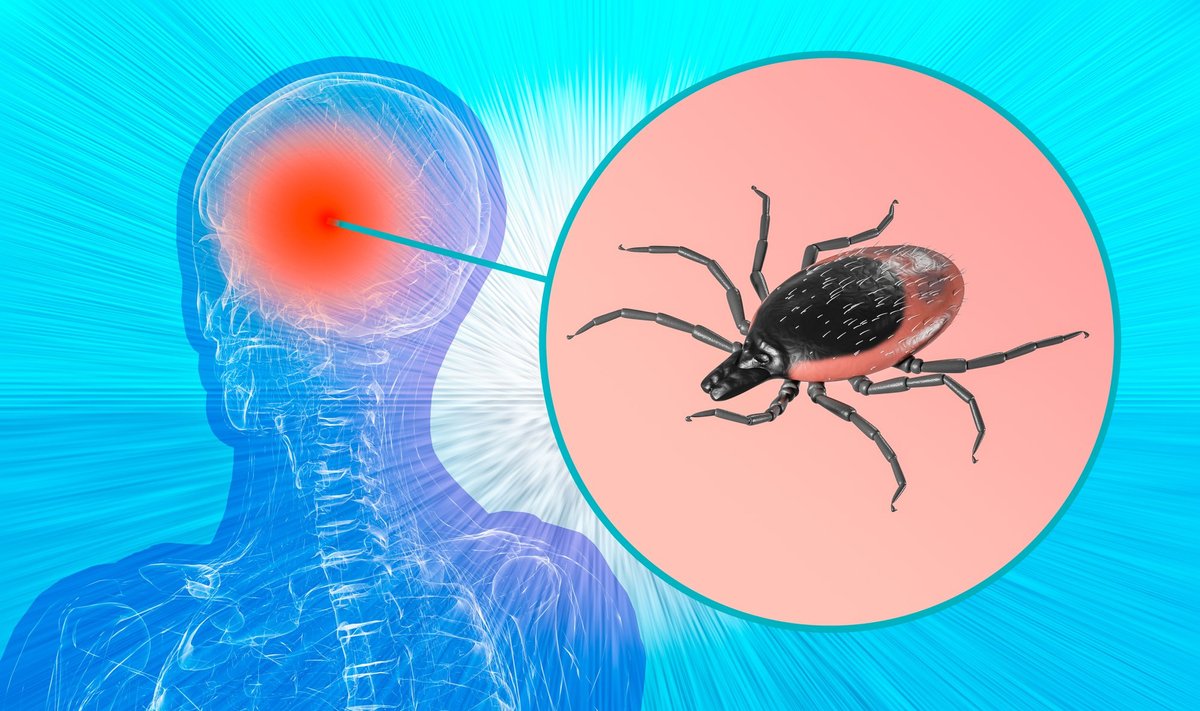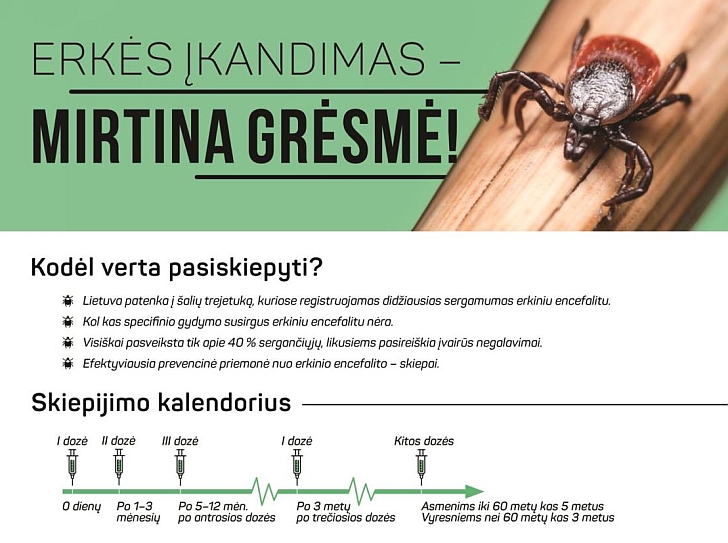
Tick-borne encephalitis is an infectious disease caused by the tick-borne encephalitis virus (EEV). It is a virus in the flavivirus family that is transmitted to humans through the bites of ticks, usually Ixodes ricinus and Ixodes persulcatus. Most often, tick-borne encephalitis is recorded in Europe and Asia, especially in places where there are many ticks.
Tick-borne encephalitis causes a serious inflammation of the central nervous system (brain and spinal cord) called enfecalitis. This can cause a range of symptoms, from mild flu-like symptoms such as fever, weakness and headache, to more severe symptoms such as loss of consciousness, seizures or paralysis. In some cases, tick-borne encephalitis can be fatal.
It is important to note that not all tick bites cause tick-borne encephalitis - only a small proportion of ticks carry the tick-borne encephalitis virus (EEV). However, if a person is bitten by a tick that carries the virus and becomes infected, it can lead to a serious and potentially life-threatening condition.
Causes and spread of tick-borne encephalitis
Tick-borne encephalitis is an infectious disease caused by the tick-borne encephalitis virus (EEV). This virus is transmitted to humans through the bites of ticks (Ixodes ricinus and Ixodes persulcatus). Most of the time, these types of ticks live in forests and meadows, so it is especially dangerous for people who often visit these places.
The life cycle of ticks and their ability to transmit the virus depends on many factors, such as temperature, humidity and the supply of their "prey" on whose blood they feed. The virus is transmitted through a tick bite, when the tick sucks the blood of an infected animal. People and animals can be infected, but they do not spread the virus themselves.
The prevalence of tick-borne encephalitis depends geographically on the distribution of ticks. Tick-borne encephalitis is common throughout Europe, Asia and the Siberian region of Russia. Especially many cases are registered in Central Europe and Northern Asia. The most dangerous period is late spring and early summer, when ticks are most active.
Tick-borne encephalitis. Symptoms
Tick-borne encephalitis is a disease that can manifest itself in two ways. After infection with tick-borne encephalitis virus (EEV), the first symptoms, which are often flu-like, may appear within the first 1-2 weeks. These can include high fever, headache, weakness, muscle and joint pain, lack of appetite and general deterioration of health. These symptoms may last from a few days to a week, after which the patient may feel better.
However, about 30% of infected individuals develop a second phase of the disease, which begins 1-2 weeks after the onset of symptoms and can be very serious. In the second stage, the virus affects the central nervous system and causes encephalitis (inflammation of the brain). Symptoms can be very varied and depend on which part of the brain is affected. These can include headache, fever, vomiting, chills, loss of consciousness, seizures, visual disturbances and other neurological symptoms.
In some cases, serious complications may occur, such as respiratory problems, cardiovascular problems, and others. It is also a potentially fatal condition that requires immediate medical attention.

What are the types of tick-borne encephalitis?
Tick-borne encephalitis has three main genotypes that can be identified based on their geographic distribution and genetic characteristics: Western (European), Siberian, and Far Eastern (Asia). These genotypes may cause slightly different clinical symptoms, but most symptoms are similar in all genotypes.
The Western (European) genotype is common throughout Europe. This genotype usually causes milder symptoms and fewer serious complications than other genotypes. However, this genotype can still cause severe encephalitis and other serious complications, especially in older people.
The Siberian genotype is common in the Siberian region of Russia and many other regions of Asia. This genotype may cause more severe symptoms and a higher risk of death than the Western genotype. There are also reports of severe long-term complications such as weakness, paralysis and brain damage.
The Far Eastern genotype is common in the Far East, including Japan, China, and Korea. This genotype can cause very severe symptoms and a high risk of death. In addition, infections of the Far Eastern genotype can cause long-term complications such as paralysis, brain damage, and psychiatric disorders.
Diagnosis and treatment
Tick-borne encephalitis is diagnosed on the basis of clinical symptoms, the patient's history (i.e. whether there was a possibility of encountering a tick, especially during the season of tick activity and in endemic areas) and the results of laboratory tests. Confirmation of the laboratory diagnosis involves the detection of specific antibodies in the patient's blood, which are produced in response to tick-borne encephalitis virus infection.
Treatment of tick-borne encephalitis is mostly symptomatic, as there is no specific drug for tick-borne encephalitis. Treatment includes reducing pain and fever, adequate hydration, and supportive care aimed at reducing symptoms and maintaining body function while the body fights the infection. In severe cases, where the central nervous system is affected, intensive care unit care, such as respiratory support or seizure control, may be required.
Prevention is an important aspect of the management of tick-borne encephalitis. This includes avoiding ticks, using tick repellants, wearing appropriate clothing in wooded areas, and of course, tick-borne encephalitis vaccination, which is an extremely effective and safe way to protect against this disease.

Consequences of the disease
The consequences of tick-borne encephalitis can be very different, depending on how hard the patient transmits the disease. Each person's response to infection is individual and depends on many factors, including their general health, age and immune system status.
Nevertheless, some patients with tick-borne encephalitis can experience severe complications. It is usually associated with brain damage that can cause long-term symptoms and consequences such as headaches, weakness, impaired coordination, epilepsy and even cognitive impairment. In particularly severe cases, serious consequences can occur, such as paralysis, mental disorders and severe brain damage that can lead to disability.
Some patients may experience post-infection syndrome, which may include persistent fatigue, difficulty concentrating, memory problems, and emotional disturbances such as depression or anxiety. These problems can last for months or even years after the patient recovers.
It is important to note that not all cases of tick-borne encephalitis become this severe. Many people experience milder symptoms, which may be similar to the flu, and can recover without long-term effects. However, given the potentially serious nature of the disease and long-term consequences, tick-borne encephalitis should be considered a serious health problem that requires careful management and treatment.
Sources of information:
Lindquist, L., & Vapalahti, O. (2008). Tick-borne encephalitis. The Lancet, 371(9627), 1861-1871.
Bogovic, P., & Strle, F. (2015). Tick-borne encephalitis: A review of epidemiology, clinical characteristics, and management. World journal of clinical cases, 3(5), 430.
Taba, P., Schmutzhard, E., Forsberg, P., Lutsar, I., Ljøstad, U., Mygland, Å., ... & ESCMID Study Group on Clinical Parasitology. (2017). EAN consensus review on prevention, diagnosis and management of tick-borne encephalitis. European journal of neurology, 24(10), 1214-e61.
Gritsun, T. S., Lashkevich, V. A., & Gould, E. A. (2003). Tick-borne encephalitis. Antiviral research, 57(1-2), 129-146.
Holzmann, H. (2003). Diagnosis of tick-borne encephalitis. Vaccine, 21, S36-S40.
Dobler, G., & Gniel, D. (2020). Tick-borne encephalitis: From microfocus to human disease. Progress in neurobiology, 192, 101868.
# erkinis encefalitas # erkes # infekcija # virusas






